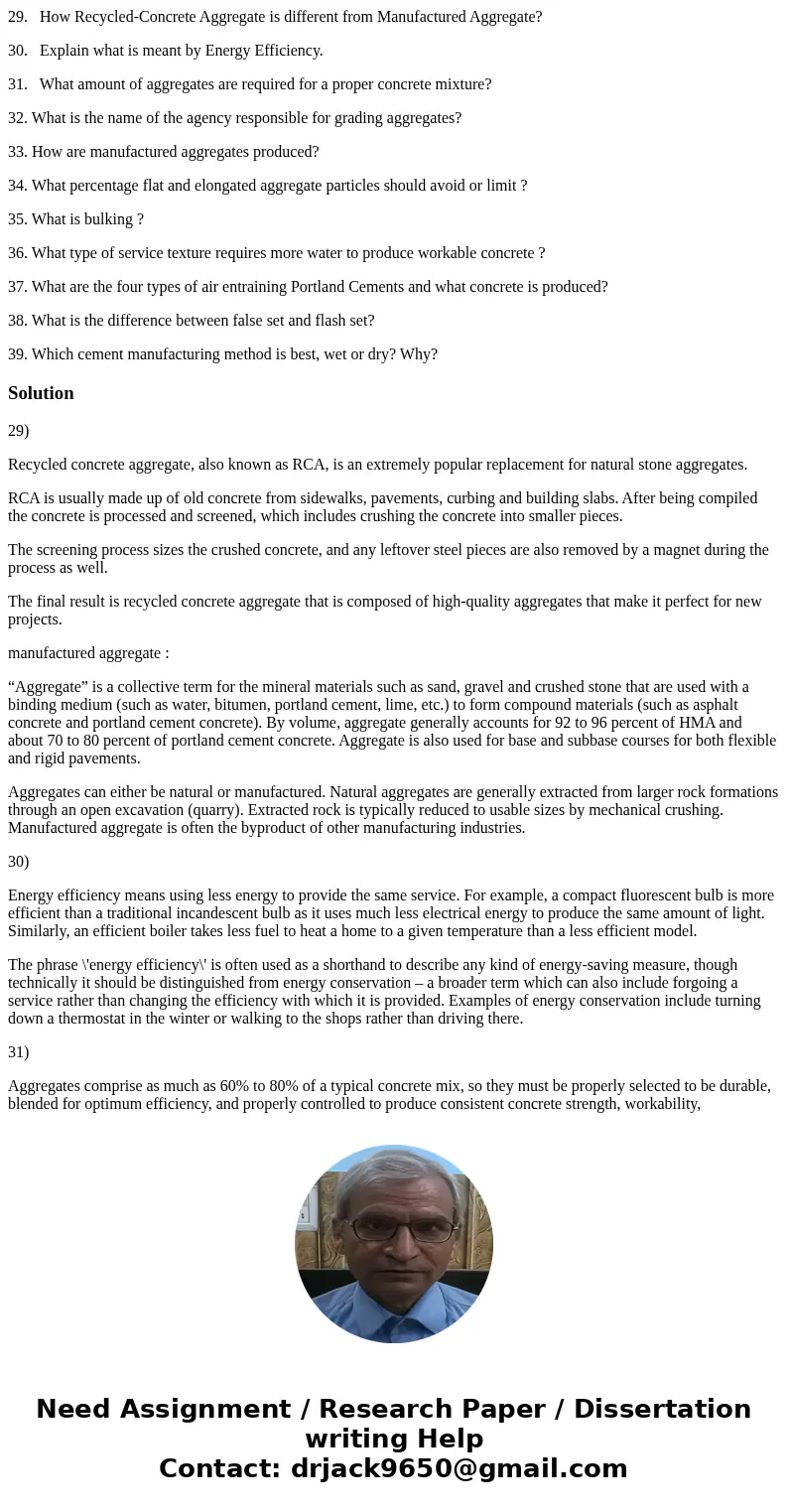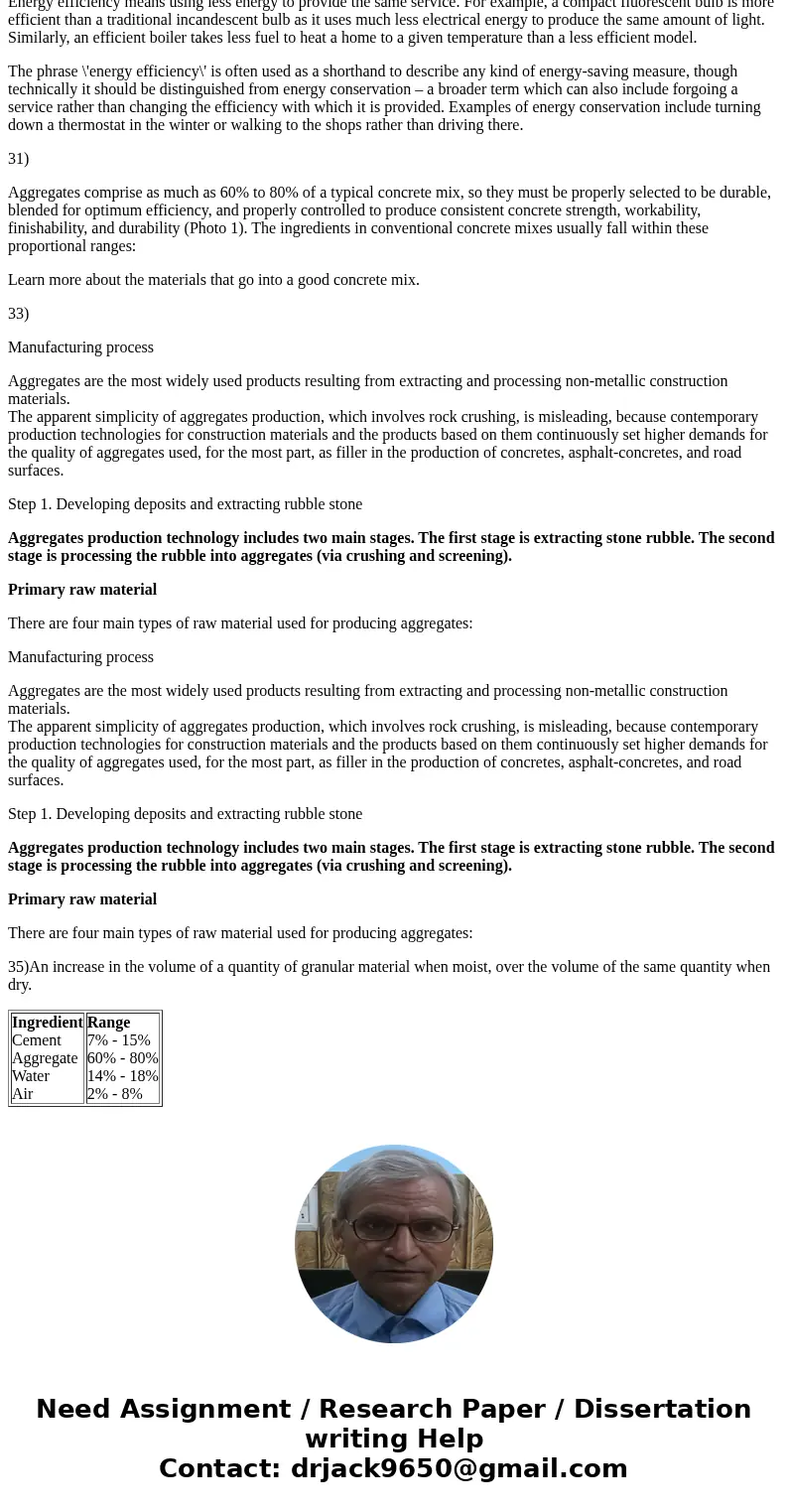29 How RecycledConcrete Aggregate is different from Manufact
29. How Recycled-Concrete Aggregate is different from Manufactured Aggregate?
30. Explain what is meant by Energy Efficiency.
31. What amount of aggregates are required for a proper concrete mixture?
32. What is the name of the agency responsible for grading aggregates?
33. How are manufactured aggregates produced?
34. What percentage flat and elongated aggregate particles should avoid or limit ?
35. What is bulking ?
36. What type of service texture requires more water to produce workable concrete ?
37. What are the four types of air entraining Portland Cements and what concrete is produced?
38. What is the difference between false set and flash set?
39. Which cement manufacturing method is best, wet or dry? Why?
Solution
29)
Recycled concrete aggregate, also known as RCA, is an extremely popular replacement for natural stone aggregates.
RCA is usually made up of old concrete from sidewalks, pavements, curbing and building slabs. After being compiled the concrete is processed and screened, which includes crushing the concrete into smaller pieces.
The screening process sizes the crushed concrete, and any leftover steel pieces are also removed by a magnet during the process as well.
The final result is recycled concrete aggregate that is composed of high-quality aggregates that make it perfect for new projects.
manufactured aggregate :
“Aggregate” is a collective term for the mineral materials such as sand, gravel and crushed stone that are used with a binding medium (such as water, bitumen, portland cement, lime, etc.) to form compound materials (such as asphalt concrete and portland cement concrete). By volume, aggregate generally accounts for 92 to 96 percent of HMA and about 70 to 80 percent of portland cement concrete. Aggregate is also used for base and subbase courses for both flexible and rigid pavements.
Aggregates can either be natural or manufactured. Natural aggregates are generally extracted from larger rock formations through an open excavation (quarry). Extracted rock is typically reduced to usable sizes by mechanical crushing. Manufactured aggregate is often the byproduct of other manufacturing industries.
30)
Energy efficiency means using less energy to provide the same service. For example, a compact fluorescent bulb is more efficient than a traditional incandescent bulb as it uses much less electrical energy to produce the same amount of light. Similarly, an efficient boiler takes less fuel to heat a home to a given temperature than a less efficient model.
The phrase \'energy efficiency\' is often used as a shorthand to describe any kind of energy-saving measure, though technically it should be distinguished from energy conservation – a broader term which can also include forgoing a service rather than changing the efficiency with which it is provided. Examples of energy conservation include turning down a thermostat in the winter or walking to the shops rather than driving there.
31)
Aggregates comprise as much as 60% to 80% of a typical concrete mix, so they must be properly selected to be durable, blended for optimum efficiency, and properly controlled to produce consistent concrete strength, workability, finishability, and durability (Photo 1). The ingredients in conventional concrete mixes usually fall within these proportional ranges:
Learn more about the materials that go into a good concrete mix.
33)
Manufacturing process
Aggregates are the most widely used products resulting from extracting and processing non-metallic construction materials.
The apparent simplicity of aggregates production, which involves rock crushing, is misleading, because contemporary production technologies for construction materials and the products based on them continuously set higher demands for the quality of aggregates used, for the most part, as filler in the production of concretes, asphalt-concretes, and road surfaces.
Step 1. Developing deposits and extracting rubble stone
Aggregates production technology includes two main stages. The first stage is extracting stone rubble. The second stage is processing the rubble into aggregates (via crushing and screening).
Primary raw material
There are four main types of raw material used for producing aggregates:
Manufacturing process
Aggregates are the most widely used products resulting from extracting and processing non-metallic construction materials.
The apparent simplicity of aggregates production, which involves rock crushing, is misleading, because contemporary production technologies for construction materials and the products based on them continuously set higher demands for the quality of aggregates used, for the most part, as filler in the production of concretes, asphalt-concretes, and road surfaces.
Step 1. Developing deposits and extracting rubble stone
Aggregates production technology includes two main stages. The first stage is extracting stone rubble. The second stage is processing the rubble into aggregates (via crushing and screening).
Primary raw material
There are four main types of raw material used for producing aggregates:
35)An increase in the volume of a quantity of granular material when moist, over the volume of the same quantity when dry.
| Ingredient Cement Aggregate Water Air | Range 7% - 15% 60% - 80% 14% - 18% 2% - 8% |


 Homework Sourse
Homework Sourse